Chives are the garden herb that keeps on giving, and when they’re overflowing in your garden, or you have extra lying around after using them in herby potato salad, then it’s time to make chive butter!
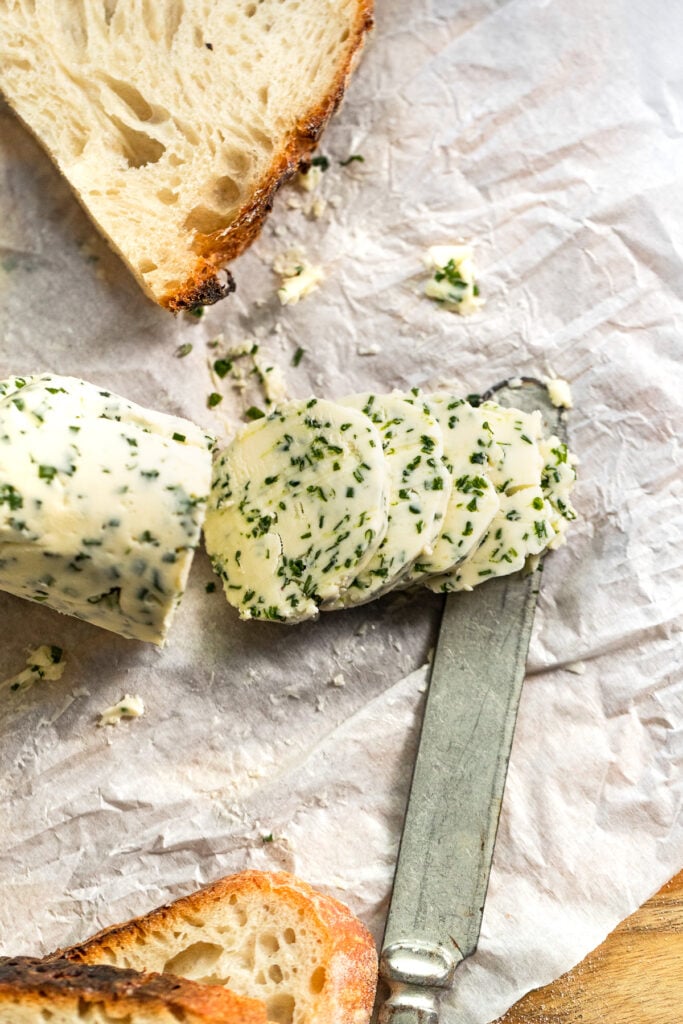
That is, after all, how this easy butter recipe came to be. I actually have three chive plants growing in my garden. Mostly because they were on sale three years ago, and they’re great companion plants next to tomatoes, and they repel a lot of certain pests.
I didn’t realize they were so prolific, that even after cutting back the entire plant, it would grow beautiful new chive stalks in a matter of weeks. Or a week? Either way, it was quick. And I had (have? always.) a copious amount of chives. So, I tossed them together with butter. My family raved, put it on everything, and said the recipe must go up on the blog.
I didn’t need more convincing.
Not only is it amazing topped on hot salmon and even tossed in homemade popcorn, but it also makes the perfect super easy (err…maybe lazy?) vegetarian appetizer – just put it out with a fresh loaf of bread, and bam, your friends will be amazed.
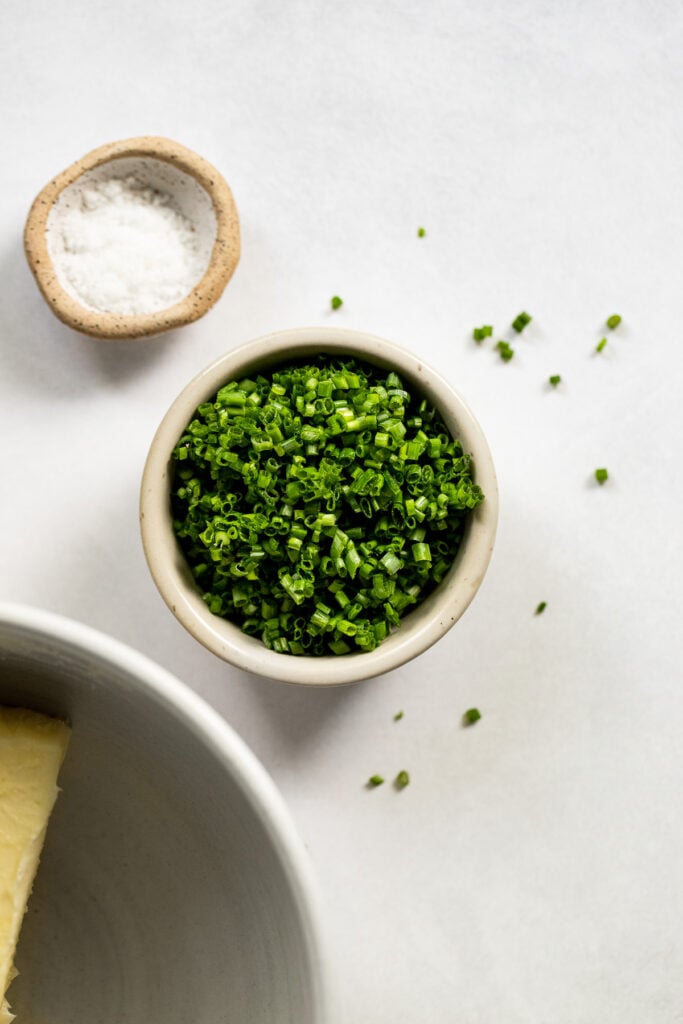
What are Chives?
Chives are part of the allium family, which includes our favorites: onion, garlic, and leeks. They’re more like an herb and often used as a garnish.
Chives have a mild-onion flavor with a hint of garlic. The plant is composed of long green stalks, and in the spring, bright purple flowers. Both are edible and excellent in omelets, fish, potatoes, salads, and more.
Simple Ingredients
The versatility of compound butter is a beautiful thing. It starts with 3 simple ingredients (or just 2, depending on your salt situation) but can be customized so easily. So just like chives, it’s kind of the recipe that keeps on giving.
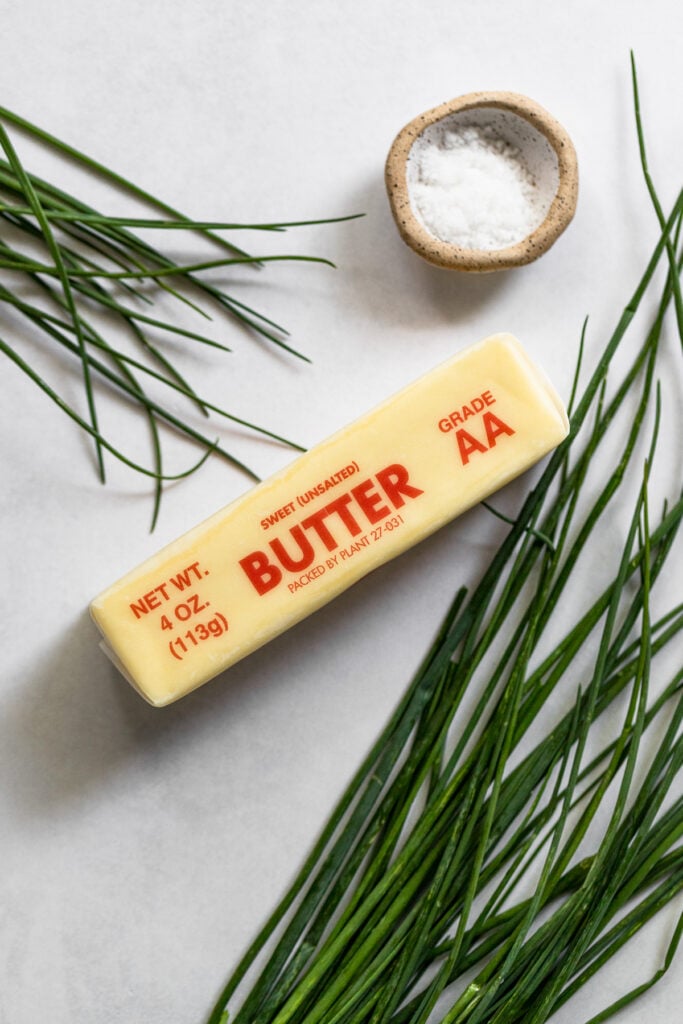
- Fresh Chives: use them from your garden or storebought.
- Butter: it will need to be room temperature, but other than that you can use salted or unsalted butter.
- Salt: if you use salted butter, you’ll probably want to skip this. And if you’d prefer to skip it anyway, feel free. A little salt brings out the flavors.
How to Make Chive Butter
This is one of those so-easy-is-it-really-a-recipe recipes.
The first step is to make sure your butter is at room temperature. If it’s not softened enough to stir, it will be difficult to combine the chives into the butter. Take it out of the fridge a few hours before you want to make the recipe. In a pinch, you can soften it in the microwave, just don’t let it melt.
Next, add the chives and salt (if using). Stir it into the butter until the chives are incorporated throughout the butter.
Finely chop the chives by laying the stems together on your cutting board. Then cut, starting from one end and working your way across, to create small little rounds. The finer you can chop them, the more they’ll be spread out in the butter.
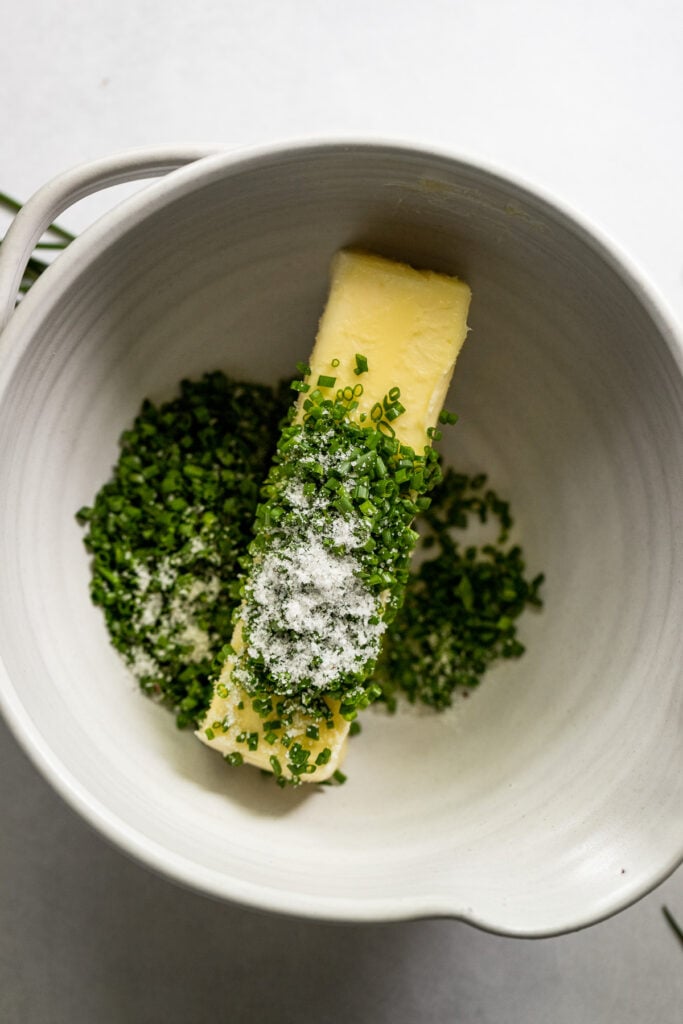
If you’re impatient (hi, me) or you’re ready to serve it immediately, then go ahead and slather it on a freshly baked piece of sourdough bread (my favorite!) or serve it as needed. However, if you’re going to save it for later, or you’d just like to make it into a fun compound butter log, now is the time.
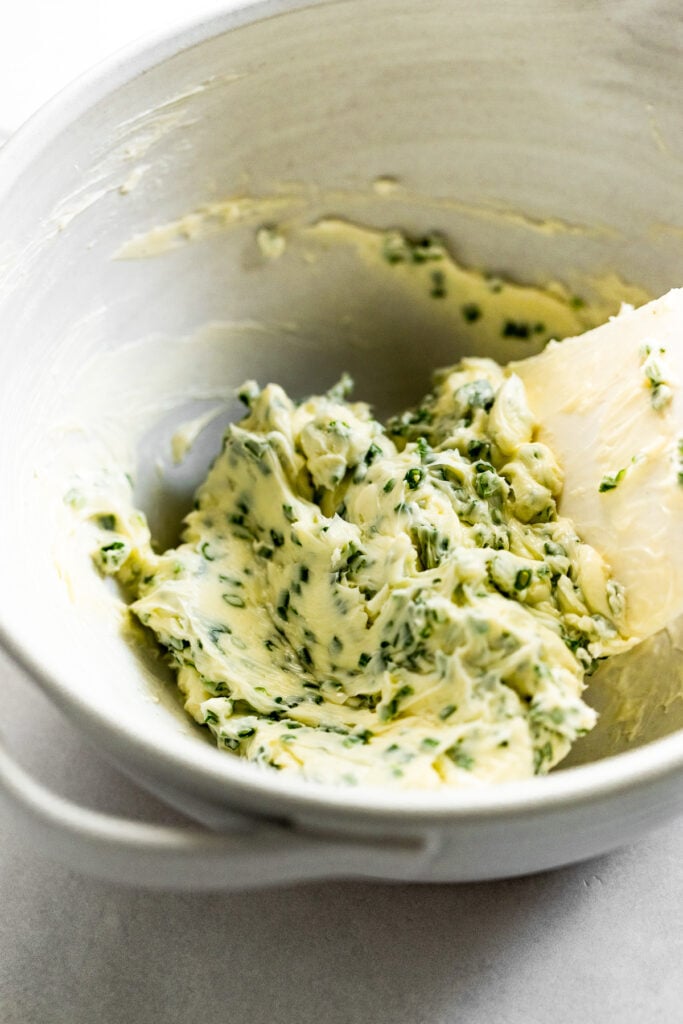
Roll a Butter Log
Lay a large piece of plastic wrap on the counter, and place the butter mixture in the middle. Plastic wrap will roll the best, but in a pinch feel free to use parchment paper.
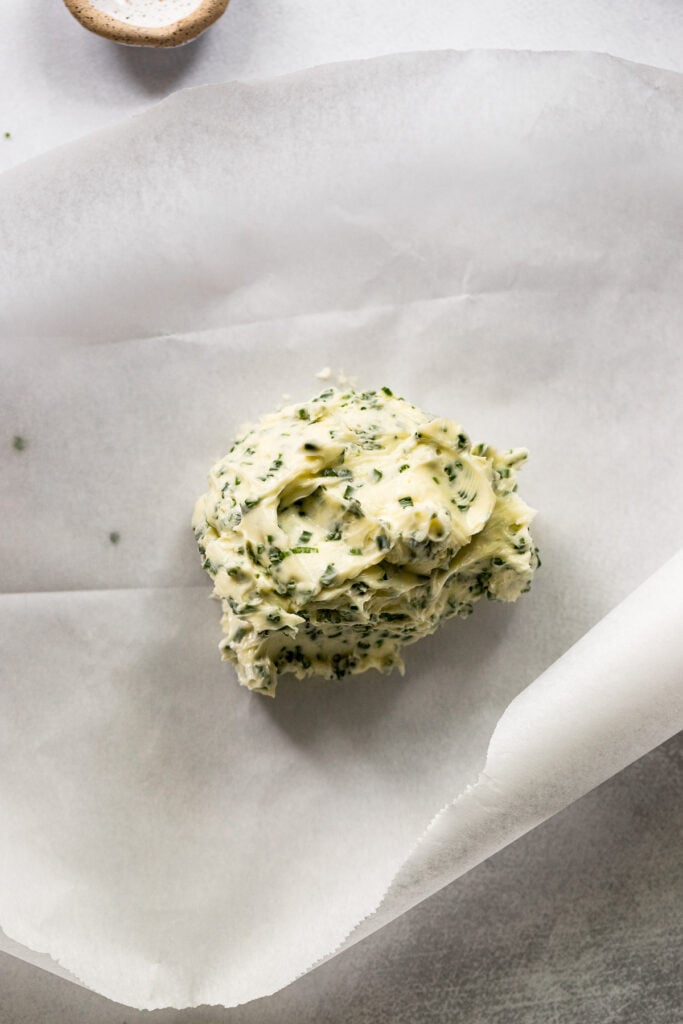
Roll the plastic wrap around the butter, forming it into a log as needed. Once you get it rolled, you can continue to roll the entire log to your desired thickness. Press in the ends as needed, too.
Remember, it doesn’t have to be perfect – it’s going to taste the same regardless of the log shape. While plastic wrap is great for rolling, it’s easiest to store it long-term in parchment or waxed paper for ease of removing the paper.
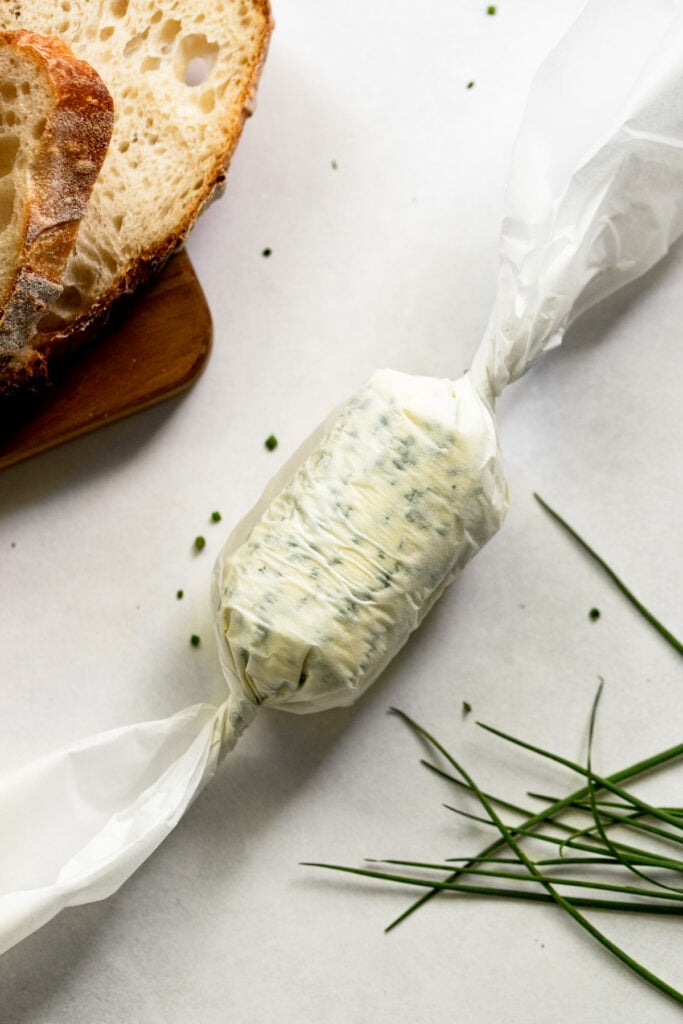
Make it Whipped!
If you’d rather have whipped chive butter, it’s just as easy to make! You’ll need the same room temperature butter, then go ahead and use a hand mixer to whip up the butter before folding in the chives. Feel free to follow my whipped honey butter recipe for reference on whipping butter.
Storage
After rolling the butter into a log, place it in the fridge to harden up. This will make it easier to cut into rounds for a beautiful presentation, and for using it on things like steak, fish, or potatoes where you’d like a nice pat of butter.
You will want to remove it from the fridge 15-20 minutes before serving, depending on your room temperature, so it softens just enough to but cut into rounds.
Chive butter will last stored in the fridge for up to one week, sometimes a little longer, but be sure to check that the herbs haven’t gone bad if using longer.
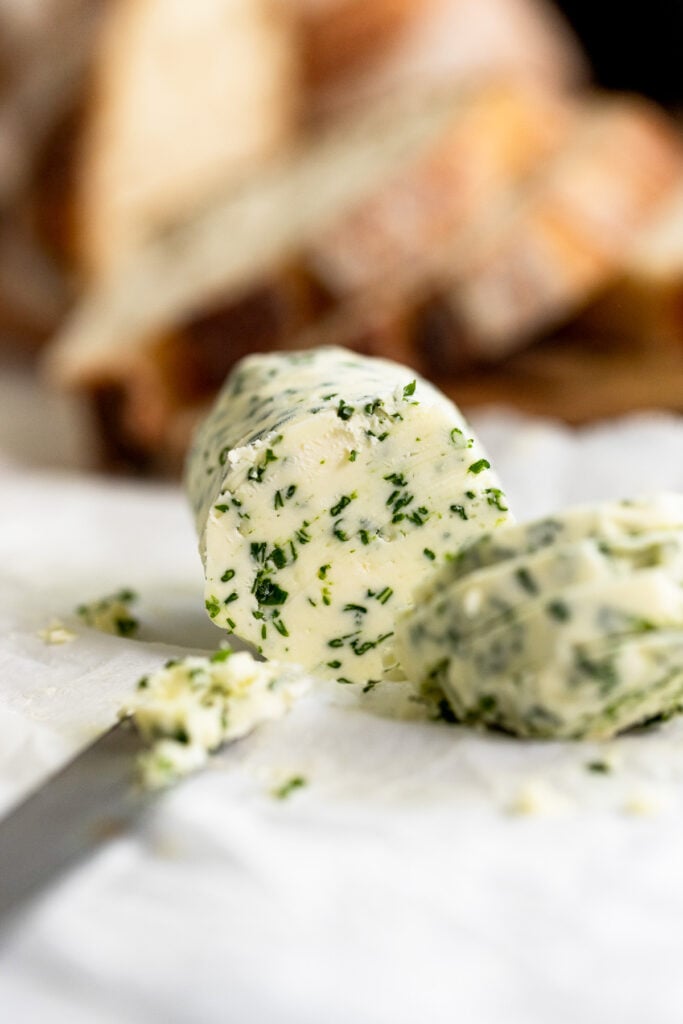
Freeze It
And if you want to store it even longer…freeze it! Then, you’ll have chive butter on hand for anytime.
You can freeze the entire log, which is best if you know you’ll want to use the entire log at a later date. Otherwise, freeze the butter in rounds so that you can easily use a pat or two as needed.
To do so, use a sharp knife to cut the log into rounds after it has hardened in the fridge. Place the rounds on a parchment paper-lined baking sheet and place the baking sheet in the freezer until they are frozen through. Once they are, transfer them to a container or freezer-safe bag for easy use.
Another great option is to spread the softened mixed butter in 2-tablespoon Souper Cubes. Place them in the freezer, then pop them out once they’re frozen through and store them in a bag for future use.
Ways to Use Herb Butter
You can put chive butter on basically…anything. From fish or grilled meats, to smashed potatoes, mashed potatoes, or baked potatoes, to roasted veggies.
It’s also amazing slathered on fresh bread, homemade flatbread, or savory muffins and scones. And of course, chives are great served with eggs (think: breakfast charcuterie board).
Let’s not forget…homemade popcorn! Replace your regular melted butter with melted chive butter and be WOWed.
Any combination that can use a little richness and mild onion flavor – it’s the most wonderful.
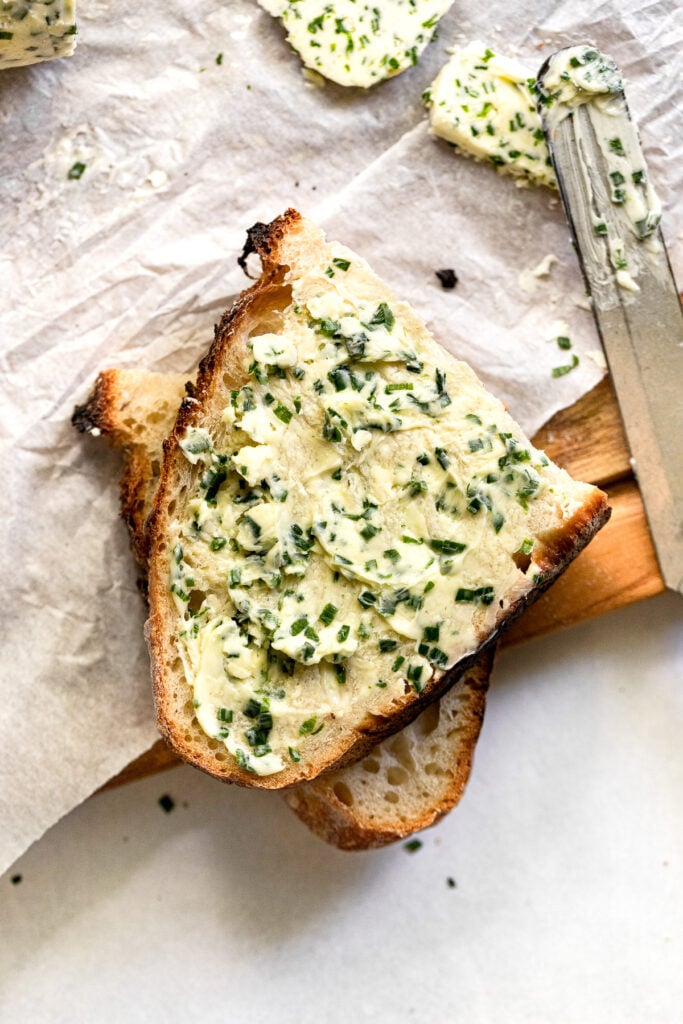
Variations
- Add a clove of pressed garlic, or garlic powder, for added garlic flavor.
- Mix in or substitute other herbs: parsley, thyme, sage, rosemary…
- Give it a little kick and add in freshly ground black pepper.
- In spring, use the chive blossom – those beautiful vibrant purple flowers on the top – add the flowers to the butter or roll the log of butter in them for a beautiful presentation.
- Use chive blossoms that have just opened and are bright in color (not ones that have become pale and papery).
Did you make this recipe? Please leave a star rating and review in the form below. I appreciate your feedback, and it helps others, too!
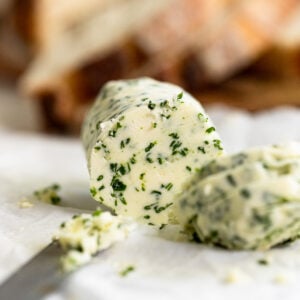
Get the Recipe Chive Butter
Ingredients
- ½ cup unsalted butter, (1 stick), room temperature
- 2-3 Tablespoons fresh chives, finely chopped
- ¼ teaspoon fine sea salt, or to taste
Instructions
- In a medium mixing bowl, add the softened butter, chopped chives, and salt. Use a spoon or spatula until completely combined. Feel free to taste test and adjust for salt as needed (or more chives!). You can use it immediately like this, or make a log.
- Make a log: Cut a large piece of plastic wrap or parchment paper and place it on your countertop. Place the butter in the middle of the sheet, and lift one side to slowly form a log shape. Press the sides in as needed, and then continue to roll it around until a log forms. Place in the fridge to harden, so it's easier to cut pats of butter. It will keep in the fridge for up to 1 week.
- Freezing: make a log as described above, and once it's hard enough to cut rounds of butter, cut and place the rounds on a parchment-lined baking sheet. Freeze, then transfer to a bag for freezer storage, for up to 3 months. When ready to use, thaw at room temperature or in the fridge.
- Enjoy it on grilled meats, fish, eggs or omelets, toast, potatoes, and more (see the post for additional ideas).
Notes
- Easily double (or triple!) the recipe for more chive butter.
- This is a chive heavy recipe and I tend to use a lot of chives in my butter; play around and find the ratio that you love.

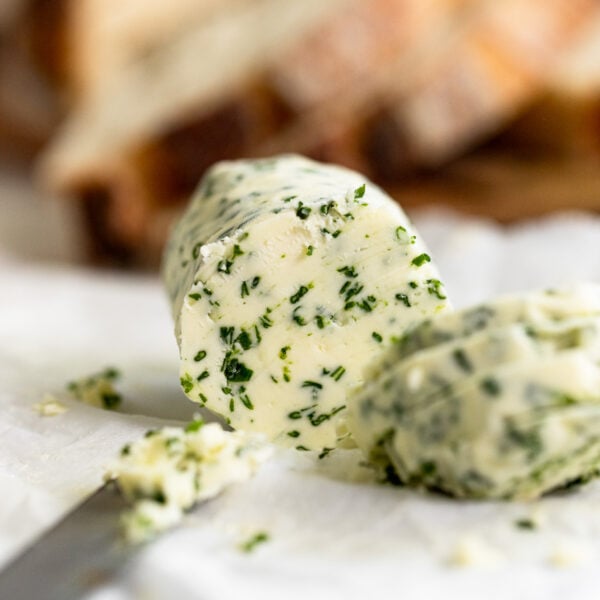




A simple recipe to follow; great butter spread as I have tried with dried herbs and garlic powder too!!! Simply loved it!!!
I’m so glad to hear! Thanks so much, Winnie!
I made this Chive Butter Recipe to have on steaks this weekend, it was DIVINE! I mean perfect on top of our ribeyes… I even spread some on my rolls. I could have probably eaten it with a spoon. Thank you for this amazing recipe. I will be making it every time we grill steaks!
Yay! I’m so glad to hear you loved it. It’s so good on just about everything – including the spoon 🙂